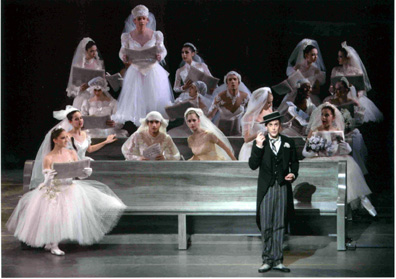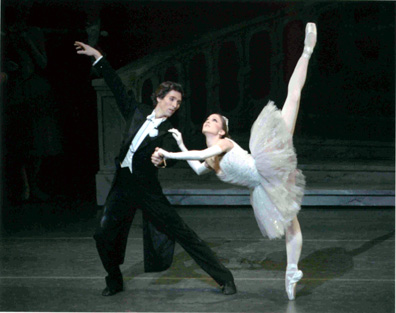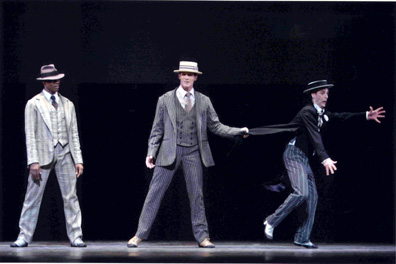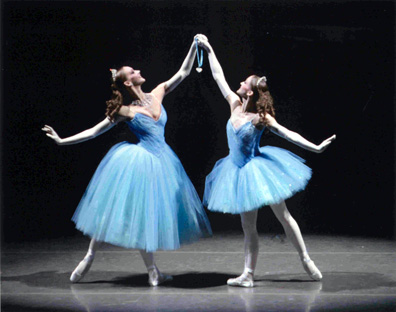All Dressed Up
By
Nancy Dalva
copyright
© 2004 by Nancy Dalva
"Working with Balanchine was like having a wonderful suit made to measure just for you," Edward Villella once told me. "With Robbins it was like getting a suit off the rack."
 There
is a couturier again at the New York City Ballet, someone who, as Arthur
Mitchell said recently of Balanchine, “for each girl in the company
did something special.” His artistry was the highlight of the Winter
Season—his nuanced, layered, allusive yet freshly imaginative takes
on tradition played out on a scale at once intimate and grand, subtle
and super. He drew on his past successes with a few self-quoting interpolations,
but his scale of reference was historical, and contextual. He sensitively
served the particular requirements of this company, attentively supporting
the principal and soloist dancers in their particular roles, reinforcing
their strong points, and showing them at their best. (You could see how
much they enjoyed being in his work.) Although he has a certain reputation
for the colorful—albeit an unfair one, given the wide range of his
previous endeavors—even his splashiest effects were deployed in
a reticent yet luxurious pallette. Even his airiest constructions, his
lightest touches, were underpinned by an architect’s sense of structure.
There was line. There was decoration. There was theme, and variation.
There
is a couturier again at the New York City Ballet, someone who, as Arthur
Mitchell said recently of Balanchine, “for each girl in the company
did something special.” His artistry was the highlight of the Winter
Season—his nuanced, layered, allusive yet freshly imaginative takes
on tradition played out on a scale at once intimate and grand, subtle
and super. He drew on his past successes with a few self-quoting interpolations,
but his scale of reference was historical, and contextual. He sensitively
served the particular requirements of this company, attentively supporting
the principal and soloist dancers in their particular roles, reinforcing
their strong points, and showing them at their best. (You could see how
much they enjoyed being in his work.) Although he has a certain reputation
for the colorful—albeit an unfair one, given the wide range of his
previous endeavors—even his splashiest effects were deployed in
a reticent yet luxurious pallette. Even his airiest constructions, his
lightest touches, were underpinned by an architect’s sense of structure.
There was line. There was decoration. There was theme, and variation.
And all of it serving a larger collaborative cause. He did not just have dancers to deal with, he had choreography, with all its particular exactions on his art. He had a libretto—two really, for two different acts—with which to contend. He had music to consider. He had scenery with which to harmonize. For he is not a choreographer, a director, or a composer. He actually is a couturier; he is William Ivey Long, the costume designer for Double Feature, the dubious, but absolutely fabulously clothed, new hit. If at times the players—under Susan Stroman’s choreographed direction—seem all dressed up with no place to go, at least they are a pleasure to look at. And a complex pleasure, at that.
 There
are two intertwined historical themes in Long’s designs for the
show—one hardly cares to call it a ballet, since the dance elements
are not relied upon to carry the narrative. For that, there are projections
not unlike the captioning in silent movies, which are indeed Double
Feature’s governing conceit. Two black and white movies with
musical accompaniment and titles, but no talking. (Get it?)
There
are two intertwined historical themes in Long’s designs for the
show—one hardly cares to call it a ballet, since the dance elements
are not relied upon to carry the narrative. For that, there are projections
not unlike the captioning in silent movies, which are indeed Double
Feature’s governing conceit. Two black and white movies with
musical accompaniment and titles, but no talking. (Get it?)
From the movie concept, Long derives his first theme: his palette. In the first act—which is more or less a melodrama—black, white, and grey, from the most saturated, inky black to stark white. In the second act, enter beige, from the muted ivory to dullest gold. The costumes still “read” as black and white, but warmer, as befits a comedy. (There is a brief apothesis scene in blue—very Fra Angelico in coloration–at the conclusion, when the color of the eponymous blue necklace, which has been the only color throughout, saturates the mother—daughter costumes.) Thus the costumes look the way black and white movies look, which is really a trick, when you consider it, because the clothes in those movies were actually not black and white. They were just shot with black and white film. Think of how important texture is in such movie clothes, providing contrast, and shading. Shoot color in black and white, and you get all kinds of grey. How to do it live? With a riot of textiles, with fabric on fabric, pattern on pattern, meticulous under layering, and overlaying. Without assuming his style, Long achieves the black and white effects mastered by Adrian, the ultimate Hollywood designer. Glamour, flattery, character support.
 These
costumes are not, however, period pieces. Long does not settle into silent-movie
era fashion, nor into the fashion moments, whatever they are, in which
the stories are supposed to take place. Instead, he seizes on ballet fashion,
whose underpinnings he must know, holding, as he does, a degree in nineteenth
century French history. Long crafts tutus—the best since Karinska—in
a panoply of styles. Pancake, powderpuff, waltz length, with bodices of
all kinds. Long, short, extended, elaborated. Just for openers—that
is, the opening razzmatazz of The Blue Necklace, he designed
black spangled tutus accessorized with mesh tights and black slippers—the
Guys and Dolls Kit Kat Girls as Black Swans. This is not surprising
from a man who, for Crazy for You, conceived a character as Serge
Diagaliev, including his hair.
These
costumes are not, however, period pieces. Long does not settle into silent-movie
era fashion, nor into the fashion moments, whatever they are, in which
the stories are supposed to take place. Instead, he seizes on ballet fashion,
whose underpinnings he must know, holding, as he does, a degree in nineteenth
century French history. Long crafts tutus—the best since Karinska—in
a panoply of styles. Pancake, powderpuff, waltz length, with bodices of
all kinds. Long, short, extended, elaborated. Just for openers—that
is, the opening razzmatazz of The Blue Necklace, he designed
black spangled tutus accessorized with mesh tights and black slippers—the
Guys and Dolls Kit Kat Girls as Black Swans. This is not surprising
from a man who, for Crazy for You, conceived a character as Serge
Diagaliev, including his hair.
Then Long makes dresses. He makes cocktail dresses that move—Karinska meets Dior’s new look. He makes a diva wrap to-die-for, with a white fur collar over chiffon. For Kyra Nichols as a wicked step-mother, he makes a real Anthony Tudor outfit, so that she looks like Lizzie Bordon grown up, in a grey organdy apron over a silk paisley dress under a lace shrug that alludes to a cardigan. For a formal party, he puts her in a grim yet chic splendor—Carabosse meets Mrs. Danvers. It’s no accident that she looks beautiful, if nasty.
Everyone in fact looks beautiful, including Damien Woetzel in ivory and cream formal wear or white tie. The little girls in grey sailor suits. Even the two nuns who make an appearance–how can you possible do black and white without nuns?—are ineffably soigné. One sleek tootsie in diaphanous black reminds us that Long did Chicago, not to mention Cabaret. Indeed the whole black and white scheme is reminiscent of his work for Nine, though here the stark contrast gives way to gradations and permutations–the whole world in grayscale.
 The
only people who don’t look beautiful arrive in the second act. They
look swell. (Far sweller, by the way, than anyone in Peter Martins’s
Thou Swell, where fashion victims abound.) For the guys of Makin’
Whoopee, Long rings changes on the broad shouldered suit, combining
the American bravado of his haberdashery for Guys and Dolls with
the European elegance of his designs for Grand Hotel (particularly
one sleek overcoat). As ever with Long, God is in the details–here
the brocade vest backs, seen only when the men remove their jackets to
dance.
The
only people who don’t look beautiful arrive in the second act. They
look swell. (Far sweller, by the way, than anyone in Peter Martins’s
Thou Swell, where fashion victims abound.) For the guys of Makin’
Whoopee, Long rings changes on the broad shouldered suit, combining
the American bravado of his haberdashery for Guys and Dolls with
the European elegance of his designs for Grand Hotel (particularly
one sleek overcoat). As ever with Long, God is in the details–here
the brocade vest backs, seen only when the men remove their jackets to
dance.
Like any fashion defilé, this one ends with bridal wear—not for one bride, but a stage full, all in pursuit of the same groom. Among them are a few men in drag, their hair concealed by quite fetching 20's style headpieces. The miracle of these dresses is that every one seems different. (Vera Wang, eat your heart out.) Long has been known for his wedding attire at least since 1975, when he made a marvelous gown for Meryl Streep for a production at the Yale Repertory Theatre. No girl who saw it didn’t want William Ivey to make her wedding dress one day. Here there are marvelous souffle dresses, lace dresses, handkerchief hemmed dresses, ruffled dresses, net dresses—a veritable ballet blanc, hell bent on reaching the altar. It’s a shame that Stroman ramps up the antics here until they become schtick, because the brides rushing about in wonderful profusion are more than enough. At the end, they give way to the bride of the hero’s heart: Alexandra Ansanelli, in a refined silver gilt and lace tutu that makes everyone else on stage look frumpy. This is Cinderella all over again, but instead of the girl with the best shoes getting the prince, the hero gets the girl with the best taste, and the most divine little boleros.
 The
scope of William Ivey Long’s designs required specialization. (You
don’t go to a tailor for a dress, to a cutter for draping, or to
a haberdasher for embroidery.) Thus the costumes were executed by eight
shops: New York City Ballet Costume Shop, Barbara Matera Ltd., Tricorne,
Inc., Euro CO. Costumes, Carelli Costumes, Jennifer Love, Timberlake Studios,
and JenKing. The millinery—the chicest hats since Tanaquil LeClerq’s
in Western Symphony—is by three shops: NYCB’s, Carelli,
and Rodney Gordon. It was worth it. One can imagine the show with different
steps, but not with different outfits. When you go see Double Feature,
sit as close as possible. From the tenth row, I felt the same thrill I
used to feel at the ballet when I was a little girl. I wanted to be the
ballerina, so I could wear her clothes.
The
scope of William Ivey Long’s designs required specialization. (You
don’t go to a tailor for a dress, to a cutter for draping, or to
a haberdasher for embroidery.) Thus the costumes were executed by eight
shops: New York City Ballet Costume Shop, Barbara Matera Ltd., Tricorne,
Inc., Euro CO. Costumes, Carelli Costumes, Jennifer Love, Timberlake Studios,
and JenKing. The millinery—the chicest hats since Tanaquil LeClerq’s
in Western Symphony—is by three shops: NYCB’s, Carelli,
and Rodney Gordon. It was worth it. One can imagine the show with different
steps, but not with different outfits. When you go see Double Feature,
sit as close as possible. From the tenth row, I felt the same thrill I
used to feel at the ballet when I was a little girl. I wanted to be the
ballerina, so I could wear her clothes.
Photos (all by Paul
Kolnik):
First: Makin' Whoopee; Tom Gold and memers of the New York City
Ballet.
Second: Ashley Bouder and Damian Woetzel in The Blue Necklace.
Third: Maria Kowroski and friends in The Blue Necklace.
Fourth: Albert Evans, Seth Orza and Tom Gold in Makin' Whoopee.
Fifth: Maria Kowroski and Ashley Bouder in The Blue Necklace.
Originally
published:
www.danceviewtimes.com
Volume 1, Number 10
March 8, 2004
Copyright
©2004 by Nancy Dalva
|
|
|